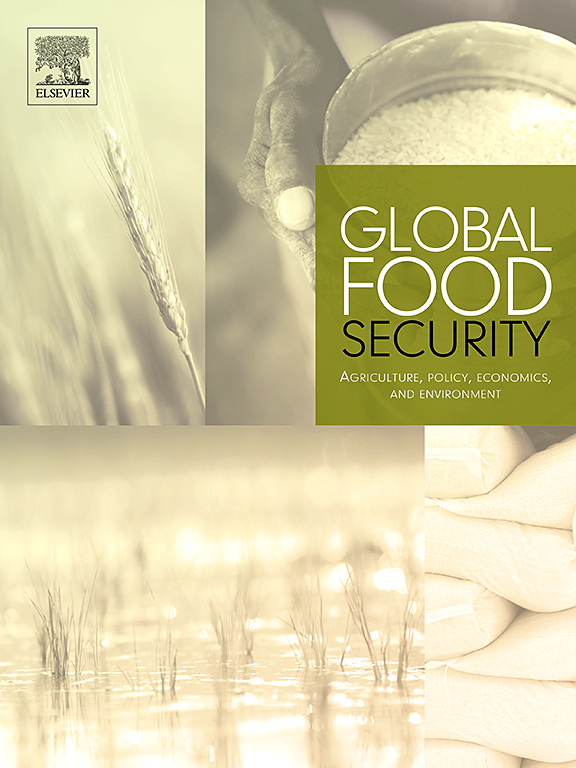次国家和针对生命周期的饮食成本估算支持营养敏感型政策和规划
IF 9.6
1区 经济学
Q1 FOOD SCIENCE & TECHNOLOGY
Global Food Security-Agriculture Policy Economics and Environment
Pub Date : 2025-03-13
DOI:10.1016/j.gfs.2025.100838
引用次数: 0
摘要
越来越多地公布国家层面的饮食成本估算,用于跟踪全球目标和比较各国之间的成本。次国家一级的估计数可以汇总成全国平均水平,可用于为地方政策和规划提供信息。本研究有两个目标:第一,评估从填补营养缺口(FNG)分析得出的国家层面的饮食成本是否与从营养食品价格(FPN)项目得出的国家估计相符,并讨论方法差异。第二,审查FNG的次国家和特定生命周期估计的附加价值,为改善最弱势群体营养的政策和规划的设计提供信息。我们检查了26个FNG国家分析中计算的能源充足和营养充足饮食成本的次国家估计和国家平均水平。我们评估了与FPN DataHub上发布的2017年相应国家级能源充足估计的相关性(r = 0.79, p <;0.001)和营养充足的饮食(r = 0.61, p = 0.001)。对于许多国家来说,国内饮食成本的次国家差异与国家之间的差异一样大。在FNG方法中考虑的个体中,发现青春期女孩营养充足饮食的成本最高。根据FNG分析对营养需求成本进行的次国家和特定生命周期估计提供了宝贵的额外信息,成功地为卫生、教育和社会保护部门的政策和方案提供了信息。本文章由计算机程序翻译,如有差异,请以英文原文为准。
Subnational and lifecycle-specific estimates of diet costs support nutrition-sensitive policies and programmes
National level estimates of diet costs are increasingly being published and serve to track global goals and compare costs across countries. Subnational level estimates, which can be aggregated to a national average, can be used to inform local policies and programmes. This study has two objectives: First, to assess whether national level diet costs from the Fill the Nutrient Gap (FNG) analysis are in line with national estimates from the Food Prices for Nutrition (FPN) Project and discuss methodological differences. Second, to review the added value of subnational and lifecycle-specific estimates from FNG to inform design of policies and programmes for improving nutrition of the most vulnerable groups. We examined the subnational estimates and national level averages of the cost of energy-sufficient and nutrient-adequate diets calculated in 26 FNG country analyses. We assessed the correlation with the corresponding national-level estimates for 2017 that were published in the FPN DataHub for energy-sufficient (r = 0.79, p < 0.001) and nutrient-adequate diets (r = 0.61, p = 0.001). For many countries, subnational variation of diet costs within the country was as large as variation across countries. Of individuals considered in the FNG approach, the cost of a nutrient-adequate diet was found to be highest for the adolescent girl. Subnational and lifecycle-specific estimates of the cost of nutrient needs from FNG analyses provided valuable additional information that has successfully informed policies and programmes in health, education and social protection sectors.
求助全文
通过发布文献求助,成功后即可免费获取论文全文。
去求助
来源期刊

Global Food Security-Agriculture Policy Economics and Environment
FOOD SCIENCE & TECHNOLOGY-
CiteScore
20.90
自引率
3.40%
发文量
69
期刊介绍:
Global Food Security plays a vital role in addressing food security challenges from local to global levels. To secure food systems, it emphasizes multifaceted actions considering technological, biophysical, institutional, economic, social, and political factors. The goal is to foster food systems that meet nutritional needs, preserve the environment, support livelihoods, tackle climate change, and diminish inequalities. This journal serves as a platform for researchers, policymakers, and practitioners to access and engage with recent, diverse research and perspectives on achieving sustainable food security globally. It aspires to be an internationally recognized resource presenting cutting-edge insights in an accessible manner to a broad audience.
 求助内容:
求助内容: 应助结果提醒方式:
应助结果提醒方式:


